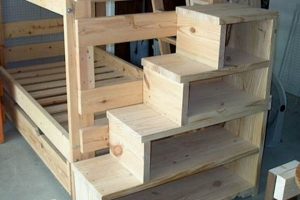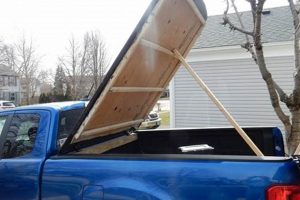Constructing a system for securing bicycles within the cargo area of a pickup truck using readily available materials and do-it-yourself methods represents a practical solution for cyclists seeking to transport their bikes safely and efficiently. This approach involves designing and building a framework, typically from wood or metal, that can be installed in the truck bed to hold bicycles upright and prevent them from shifting during transit. An example would be a wooden structure with slots cut to accommodate the bicycle’s front tire, preventing it from rolling.
The significance of creating such a system lies in its potential cost-effectiveness compared to commercially available alternatives, as well as the ability to tailor the design to specific truck bed dimensions and bicycle types. Historically, transporting bikes in truck beds often involved haphazard methods that risked damage to both the bicycles and the vehicle. This approach offers a more secure and organized method, reducing the likelihood of damage and increasing peace of mind for the cyclist. Furthermore, it allows for maximum utilization of truck bed space when compared to some commercial options.
The subsequent sections will delve into the various design considerations, material choices, and construction techniques involved in creating a custom bicycle transport solution for a pickup truck bed, providing guidance for individuals interested in undertaking this project.
Essential Construction Considerations
The following points provide crucial guidance for individuals considering the construction of a custom bicycle transport system for a pickup truck bed. Adhering to these principles will enhance the safety, stability, and longevity of the completed project.
Tip 1: Material Selection is Paramount: Employ durable materials such as pressure-treated lumber or steel for the framework. These materials offer resistance to environmental factors and structural integrity under load. Untreated wood, for instance, is susceptible to rot and should be avoided.
Tip 2: Precise Measurement and Fit: Accurately measure the truck bed dimensions and bicycle wheelbases to ensure a snug and secure fit. An ill-fitting structure can lead to instability and potential damage. Consider creating a template before final construction.
Tip 3: Secure Mounting Mechanisms: Utilize robust fastening systems to anchor the rack to the truck bed. Options include bolting directly to the bed or employing clamping mechanisms. Avoid relying solely on friction for stability.
Tip 4: Bicycle Protection Measures: Incorporate padding or protective surfaces at contact points between the bicycles and the rack to prevent scratches and abrasions. Consider using rubberized coatings or foam padding.
Tip 5: Stability Augmentation: Implement cross-bracing or triangulation in the rack’s design to enhance its structural rigidity and prevent swaying during transit. Diagonal supports significantly improve overall stability.
Tip 6: Consider Adjustable Features: Implement adjustable components where possible, especially if different bicycle models or wheel sizes may be transported. This adds versatility to your system.
Adhering to these guidelines will facilitate the creation of a secure and effective bicycle transport solution, minimizing the risk of damage and ensuring the safe conveyance of bicycles.
The subsequent section will address potential challenges and provide solutions to common issues encountered during the construction process.
1. Material Durability
Material durability serves as a foundational element in the successful execution of a “bike rack truck bed diy” project. The selection of materials directly influences the structural integrity, longevity, and overall safety of the resulting bicycle transport system. Inferior materials, prone to degradation or failure under stress, compromise the stability of the rack and increase the risk of damage to the bicycles being transported. For instance, untreated lumber exposed to the elements will quickly rot, weakening the structure and potentially causing it to collapse during transit, while steel with inadequate corrosion protection may rust, similarly diminishing its load-bearing capacity.
The implementation of durable materials translates directly into long-term cost savings and reduced maintenance requirements. While initially more expensive, pressure-treated lumber or powder-coated steel resist environmental degradation, minimizing the need for frequent repairs or replacements. This is particularly relevant given that truck beds are exposed to rain, sunlight, and varying temperatures, all of which can accelerate material breakdown. A system constructed from durable materials offers enhanced peace of mind, ensuring secure bicycle transport even under demanding conditions.
In summary, material durability is not merely a desirable attribute but rather a crucial prerequisite for a successful “bike rack truck bed diy” project. The selection of robust, weather-resistant materials directly impacts the safety, reliability, and longevity of the bicycle transport system, mitigating risks and maximizing the return on investment. The long-term benefits of choosing durable materials far outweigh the initial cost considerations, ensuring a stable and dependable solution for transporting bicycles in a pickup truck bed.
2. Structural Integrity
Structural integrity, in the context of “bike rack truck bed diy”, represents the system’s ability to withstand applied forces and maintain its intended shape and function. It is a critical factor in ensuring the safe and reliable transport of bicycles within a pickup truck bed.
- Material Strength and Load Capacity
The inherent strength of the chosen materials dictates the rack’s load-bearing capacity. For instance, a rack constructed from thin-gauge steel tubing may buckle under the weight of multiple bicycles, while one built from reinforced steel profiles would provide sufficient support. Exceeding the material’s load limit results in deformation or catastrophic failure, jeopardizing the bicycles and potentially causing accidents.
- Joint Design and Execution
The manner in which individual components are joined together significantly influences the overall structural integrity. Weak or improperly executed joints, such as poorly welded seams or loose bolted connections, create points of vulnerability. For example, a welded joint that lacks proper penetration will fail prematurely under stress, while a bolted joint without adequate torque can loosen over time, compromising the rack’s stability.
- Frame Geometry and Bracing
The geometric design of the rack’s frame, including the strategic placement of bracing elements, contributes to its resistance to bending and twisting forces. A well-designed frame incorporates triangulation and cross-bracing to distribute loads evenly and prevent localized stress concentrations. Conversely, a poorly designed frame lacking adequate bracing will exhibit excessive flex and is more susceptible to failure.
- Fastener Selection and Placement
The type and placement of fasteners used to secure the rack to the truck bed are critical for transferring loads effectively. Insufficiently sized fasteners or improper placement can lead to loosening, slippage, or even complete detachment of the rack. For example, using small-diameter bolts without washers to secure the rack to the truck bed floor may result in the bolts pulling through the metal under heavy loads, causing the entire system to fail.
These facets illustrate how structural integrity fundamentally underpins the functionality and safety of any “bike rack truck bed diy” project. Compromises in any of these areas can lead to diminished performance, increased risk of damage, and potential hazards during transportation. Therefore, careful consideration must be given to material selection, joint design, frame geometry, and fastener selection to ensure a robust and reliable bicycle transport system.
3. Secure Attachment
The concept of secure attachment is paramount in any “bike rack truck bed diy” undertaking. It directly influences the stability and safety of the entire system, ensuring that the bicycle rack remains firmly affixed to the truck bed during transit, irrespective of road conditions or driving maneuvers. A failure in secure attachment can lead to catastrophic consequences, including damage to the bicycles, the vehicle, and potential hazards to other motorists.
- Mounting Point Integrity
The strength and suitability of the mounting points within the truck bed are crucial. Existing tie-down points may not be adequately rated to withstand the dynamic forces exerted by a loaded bike rack. Directly bolting through the truck bed requires careful consideration of the underlying structure to prevent deformation or pull-through under stress. For example, simply attaching a rack to the thin sheet metal of the truck bed floor without reinforcement will likely result in failure over time, especially when transporting heavier bicycles or navigating rough terrain.
- Fastener Selection and Torque
The choice of fasteners and the proper application of torque are critical for maintaining a secure connection. Undersized bolts or screws are prone to shearing or stripping, while over-tightening can damage the mounting surface or weaken the fastener itself. A practical example involves using grade 8 bolts with properly sized washers and lock nuts to distribute the load and prevent loosening due to vibration. Adhering to manufacturer torque specifications is essential for achieving optimal clamping force without compromising fastener integrity.
- Clamping Mechanisms
Alternative attachment methods, such as clamping mechanisms, offer a non-destructive approach to securing the rack. However, the design and execution of these mechanisms must be robust to prevent slippage or detachment. For instance, using adjustable clamps with rubber padding to grip the bed rails can provide a secure hold without damaging the truck’s finish. The clamping force must be sufficient to resist lateral and vertical movement, particularly during sudden stops or turns.
- Regular Inspection and Maintenance
Even with a well-designed and properly installed attachment system, regular inspection and maintenance are essential. Vibration and exposure to the elements can gradually loosen fasteners or degrade clamping mechanisms. Periodically checking the tightness of bolts, inspecting for corrosion, and replacing worn components are crucial for maintaining a secure connection over time. Neglecting these routine checks can compromise the integrity of the attachment system and increase the risk of failure.
These considerations highlight the importance of a meticulous approach to secure attachment in any “bike rack truck bed diy” project. Ensuring robust mounting points, selecting appropriate fasteners, employing effective clamping mechanisms (if applicable), and implementing a regular inspection schedule are essential for safeguarding bicycles and ensuring safe transport.
4. Bicycle Protection
The successful execution of a “bike rack truck bed diy” project hinges significantly on the integration of effective bicycle protection measures. The primary purpose of such a rack is to transport bicycles safely and securely; therefore, minimizing the risk of damage during transit is paramount. The design and construction must account for potential sources of harm, including abrasion, impact, and environmental exposure. Failure to adequately address bicycle protection can render the entire endeavor ineffective, resulting in costly repairs or replacement of damaged bicycles. For example, a rack lacking appropriate padding may cause scratches and dents to the bicycle frame, particularly during long journeys or over rough terrain.
Several practical considerations arise when addressing bicycle protection. The choice of materials plays a crucial role; using non-abrasive surfaces like rubber or foam padding at contact points prevents scratches and chafing. Securely fastening the bicycles to the rack, using straps or clamps with appropriate tension, minimizes movement and reduces the likelihood of impact damage. Furthermore, the overall rack design should ensure adequate spacing between bicycles to prevent them from colliding with each other or the truck bed sides. Consider a scenario where multiple bicycles are transported in a rack with insufficient spacing; even minor vibrations during transit can cause the bicycles to rub against each other, resulting in significant paint damage and potential component misalignment. Effective design mitigates such risks.
In summary, bicycle protection is not merely an ancillary concern but an integral component of a well-executed “bike rack truck bed diy” project. By prioritizing non-abrasive materials, secure fastening mechanisms, and thoughtful rack design, the risk of damage to transported bicycles can be significantly reduced. The practical significance of this understanding lies in the preservation of valuable equipment and the avoidance of unnecessary repair costs, ultimately contributing to a more satisfying and economical cycling experience.
5. Space Optimization
Space optimization, when considered in the context of “bike rack truck bed diy”, denotes the efficient utilization of available cargo area within a pickup truck bed while accommodating bicycles. The creation of a bicycle rack invariably impacts the overall volume available for transporting other goods. Consequently, a primary design objective is to minimize the rack’s footprint and maximize the remaining usable space. This imperative stems from the practical need to transport bicycles alongside other cargo, such as camping equipment, tools, or building materials. An inefficient design diminishes the truck’s overall utility, potentially negating the benefits of having a bicycle transport solution.
Effective space optimization strategies manifest in several ways. Vertical orientation of bicycles, where they are mounted upright rather than horizontally, is a common technique. This approach leverages the vertical dimension of the truck bed, minimizing the surface area consumed. Furthermore, the integration of storage compartments within the rack structure allows for the consolidation of bicycle-related accessories, such as helmets, pumps, and repair kits. For instance, a design that incorporates lockable storage boxes beneath the bicycle mounting points not only secures valuable items but also prevents them from occupying additional space within the truck bed. The outcome is a more organized and functional cargo area.
In conclusion, space optimization is an indispensable component of a successful “bike rack truck bed diy” project. It directly affects the versatility and practicality of the resulting transport system. Prioritizing efficient design and integration of storage solutions ensures that the bicycle rack enhances, rather than diminishes, the overall utility of the pickup truck, allowing for the simultaneous transport of bicycles and other essential cargo. Failure to address space optimization can lead to a compromised solution that fails to meet the diverse needs of the user.
Frequently Asked Questions
The following questions address common concerns and considerations regarding the construction and implementation of a do-it-yourself bicycle rack for a pickup truck bed. The answers provide information to assist individuals in making informed decisions and achieving a safe and effective solution.
Question 1: What is the minimum required load capacity for a “bike rack truck bed diy” system designed to carry two adult bicycles?
The minimum required load capacity should account for the combined weight of the bicycles plus a safety margin to accommodate dynamic forces encountered during transit. A conservative estimate would be 100 pounds per bicycle, resulting in a minimum capacity of 200 pounds plus a 25% safety factor, yielding a total required capacity of 250 pounds. The rack’s materials and construction techniques must be adequate to support this load without deformation or failure.
Question 2: What are the potential legal liabilities associated with operating a “bike rack truck bed diy” system that is improperly secured or constructed?
Operating a bicycle rack that is improperly secured or constructed can expose the vehicle operator to significant legal liabilities. If a bicycle detaches from the rack and causes damage or injury, the operator may be held liable for negligence. Furthermore, improperly secured loads can violate traffic laws, resulting in fines or other penalties. It is imperative to ensure that the rack complies with all applicable regulations and is securely attached to the truck bed.
Question 3: How can one mitigate the risk of theft when using a “bike rack truck bed diy” system?
Mitigating the risk of theft requires incorporating security measures into the rack’s design and usage. Employing locking mechanisms to secure the bicycles to the rack and the rack to the truck bed is essential. Additionally, parking in well-lit areas and avoiding leaving bicycles unattended for extended periods can deter potential thieves. Cable locks and hardened chains can provide an additional layer of security.
Question 4: What are the key considerations for protecting bicycles from environmental elements when using a “bike rack truck bed diy” system?
Protecting bicycles from environmental elements requires implementing measures to shield them from rain, sunlight, and road debris. Using waterproof covers or tarpaulins can protect bicycles from rain and snow. Applying UV-resistant coatings to exposed components can mitigate the damaging effects of sunlight. Positioning the bicycles away from the front of the truck bed can minimize exposure to road spray and debris.
Question 5: How does the choice of truck bed liner (e.g., spray-in, drop-in) impact the design and installation of a “bike rack truck bed diy” system?
The type of truck bed liner significantly influences the design and installation of the bicycle rack. Spray-in liners provide a textured surface that can enhance grip but may complicate direct bolting. Drop-in liners create a physical barrier between the rack and the truck bed, requiring alternative mounting solutions. The design must account for the liner’s thickness and material properties to ensure a secure and stable attachment.
Question 6: What are the recommended tools and safety equipment for undertaking a “bike rack truck bed diy” project?
The required tools and safety equipment vary depending on the chosen materials and construction techniques. However, common requirements include measuring tools (tape measure, level), cutting tools (saw, angle grinder), drilling tools (drill, drill bits), fastening tools (wrenches, screwdrivers), and safety equipment (safety glasses, gloves, hearing protection). Adhering to safe operating procedures and wearing appropriate protective gear is essential to prevent injury.
In summary, a thorough understanding of load capacity, legal liabilities, theft prevention, environmental protection, truck bed liner compatibility, and tool safety is crucial for a successful “bike rack truck bed diy” project.
The next section will delve into case studies of successful “bike rack truck bed diy” projects, providing practical examples and lessons learned.
Concluding Considerations for “Bike Rack Truck Bed DIY”
This exploration of “bike rack truck bed diy” has underscored the importance of careful planning, material selection, and construction techniques. The success of such a project hinges upon a comprehensive understanding of structural integrity, secure attachment methods, bicycle protection measures, and efficient space utilization. Adherence to these principles minimizes risks and maximizes the utility of the resulting bicycle transport system.
The decision to embark on a “bike rack truck bed diy” endeavor requires a commitment to safety, precision, and ongoing maintenance. The long-term value lies not only in cost savings but also in the satisfaction of creating a custom solution tailored to specific needs. However, individuals should diligently assess their skills and resources before proceeding, recognizing that a poorly executed project can compromise both safety and financial investment.







